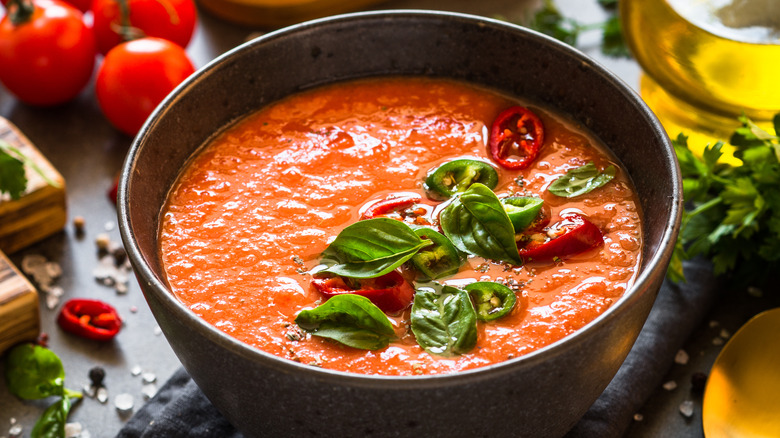What's The Difference Between Salmorejo And Gazpacho?
Staying cool at the height of summer is a challenge most of us are all too familiar with, and one clever trick for beating the heat comes straight from the palace-speckled southern climes of Andalucía, Spain. This western Mediterranean country's southernmost region, which is known for its sweltering summers, offers up not one but two cold summer soup staples: gazpacho and salmorejo. These names adorn menu boards across Andalucía, but they've also put in appearances on restaurant tables and in recipe recommendations the world over.
And yet, despite the shared qualities of this reddish-tinged soup duo when taken at face value, these tomato-based beacons of the Spanish culinary tradition are refreshing treats in their own right. The light and sunny gazpacho and the heartier, creamier salmorejo differ in key ways. For one thing, despite its derivation from the Arabic word for "soaked bread," gazpacho doesn't include as much bread as its more robust cousin (though it's sometimes thickened with bread crumbs). Salmorejo, in turn, lacks the signature fresh, moisture-laden ingredients (like cucumbers and peppers) of gazpacho. But there are many more key distinctions that run deep into the bowl (or glass).
Gazpacho is essentially a liquid salad
Following gazpacho's early mentions in ancient Greek and Roman literary manuscripts, the jury is still out on this tomato-forward soup's true origins. However, its modern iteration shines the culinary spotlight on classic Mediterranean ingredients, rendering this refresher an ode to the much-lauded benefits of the Mediterranean diet.
While many Spanish cookbooks refer to gazpacho as a liquid salad thanks to its thin consistency and reliance on raw ingredients (subscribers to the raw food movement and juice enthusiasts, rejoice!), extolling the dish's vitamin-rich virtues is but half the story. As well as being packed with vitamins A, C, and E (we all know what that spells), gazpacho basks in the brilliant red hue of its star ingredient, the tomato. Buoyed by a rejuvenating base mix of garlic, vinegar, olive oil, cucumbers, onions, and green peppers, it's an ideal way to keep the summer heat at a comfortable distance.
While regional gazpacho recipe variations abound, like the almond-and-grape medley that decorates tables across Málaga, Spain, this juice-esque concoction always goes down smoothly — especially when enjoyed in a glass. Virgin Bloody Mary, anyone? Gazpacho is even extremely easy to make at home — provided, of course, that your go-to blending tool of choice is within reach and there's chilling space in the fridge.
Salmorejo features bread and tomatoes reinvented
Spanish gastronomy serves up another refreshing, tomato-based summer cooler in the form of gazpacho's salmon-hued and heartier counterpart, salmorejo. This tomato-based recipe is altogether creamier and more favorable at dinnertime for an extra ladleful of sustenance; it's not diluted by the water content of additional vegetables. Instead, salmorejo is the soup you want at the end of a long, hard day — it packs extra oomph and density owing to its lashings of bread and garlic, making for ideal comfort food. Unlike its more skimmed-tasting relative, salmorejo is always served in a bowl.
Home cooks can even leverage this silky purée as a sauce or dip for a gourmet gathering, though The New York Times notes that the original Spanish version calls for as much as triple the olive oil you might find in a homemade recipe! The proverbial cherry on top for salmorejo is a traditional protein-packed garnish like Spanish smoked ham or cubed hard-boiled eggs. Diced peppers or poblano chilies provide a vegetarian option that is also especially fitting for the lighter gazpacho.
Should you find yourself nowhere near home — or the home of someone with a blender and a few choice tomatoes (and you're not currently sunning yourself in Spain, either) — it's possible that at least one of these tomato-based summer soups will be available at your nearest supermarket or eatery. It'll probably be the more ubiquitous gazpacho, but you can hunt for salmorejo, too, now that you know what to look for.


